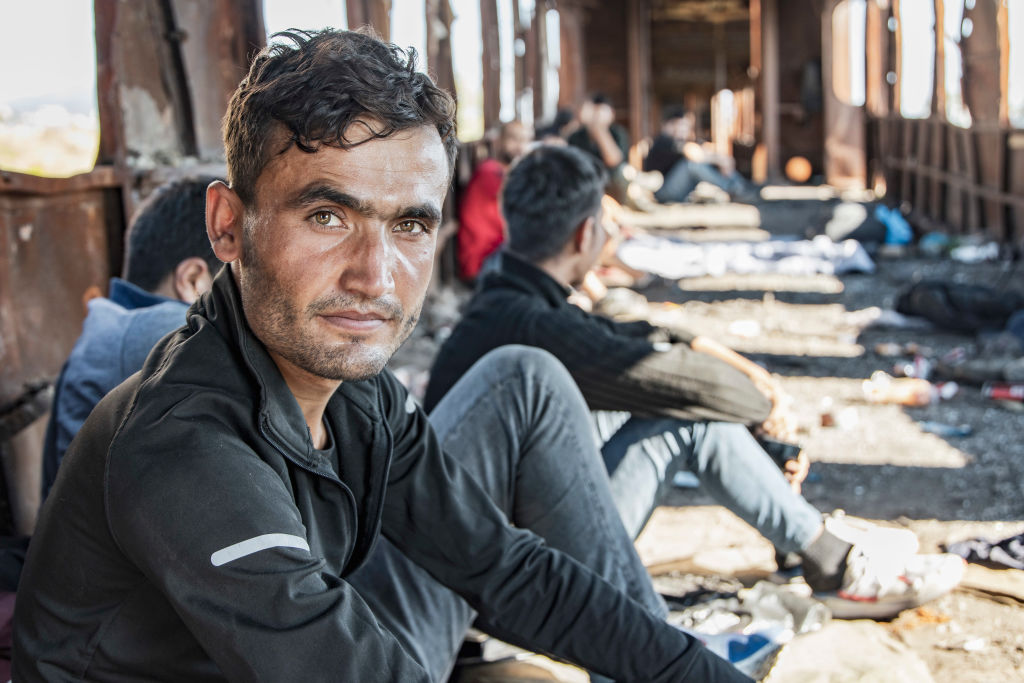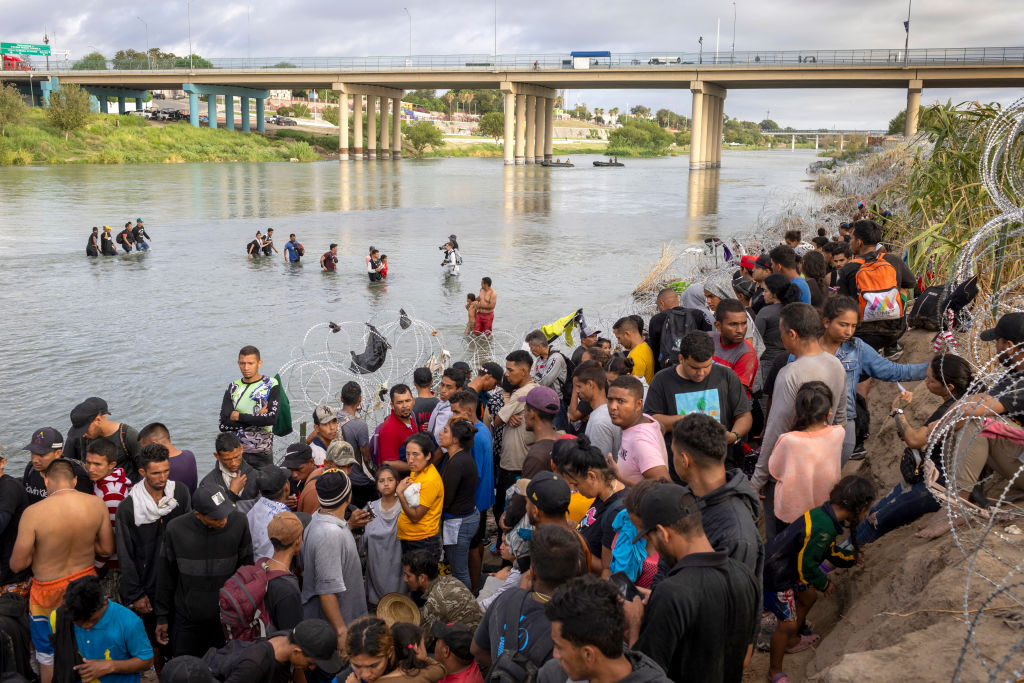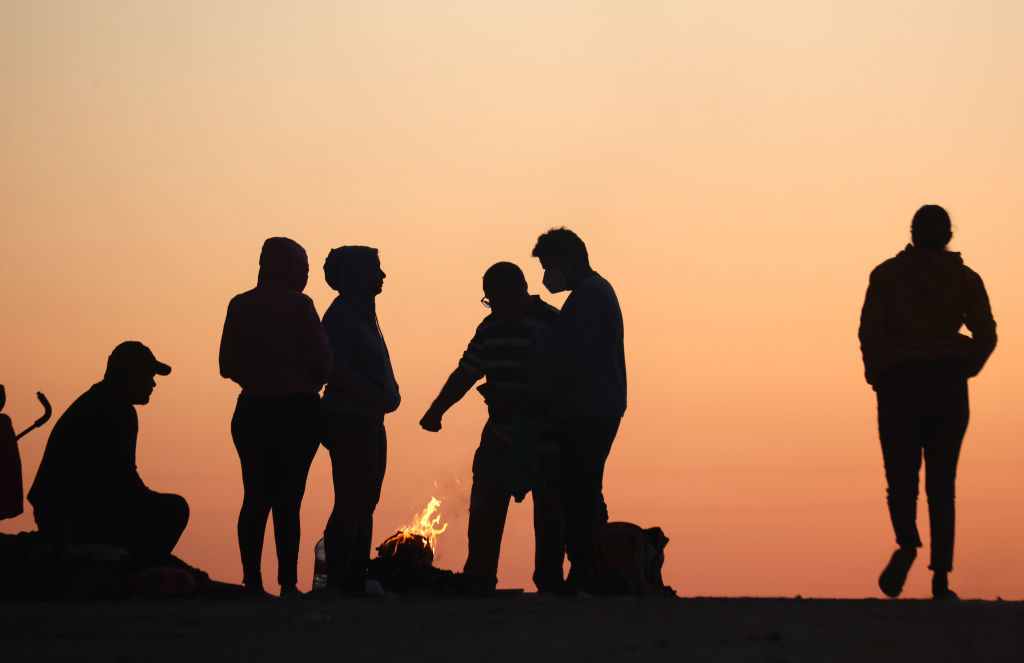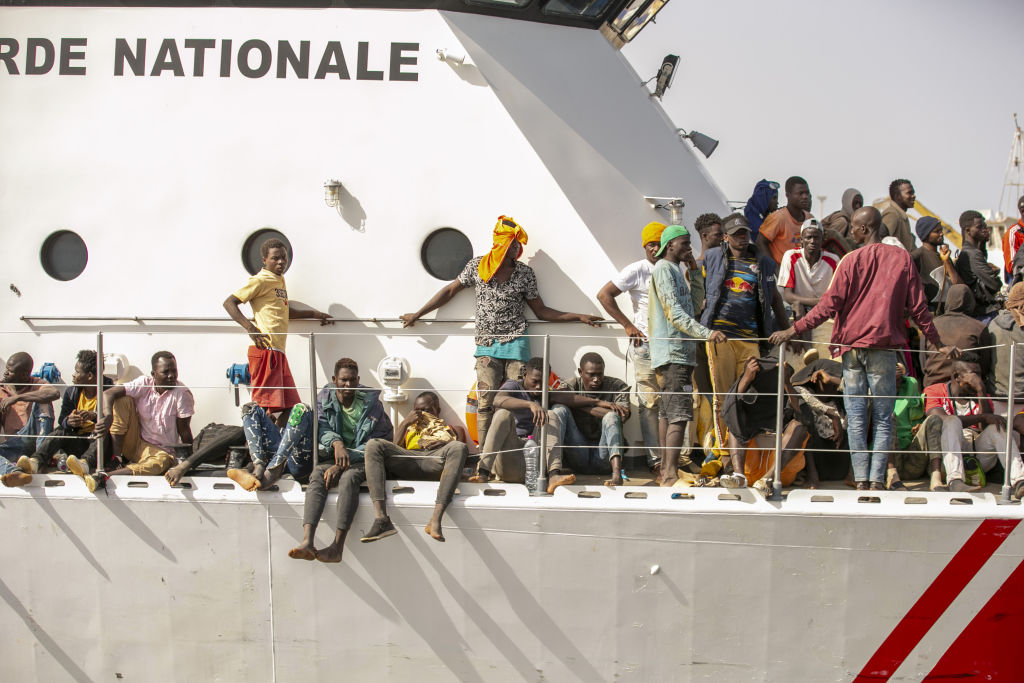Time to recall the bloody history of border crossings from Syria.
Are Borders Back in Europe?
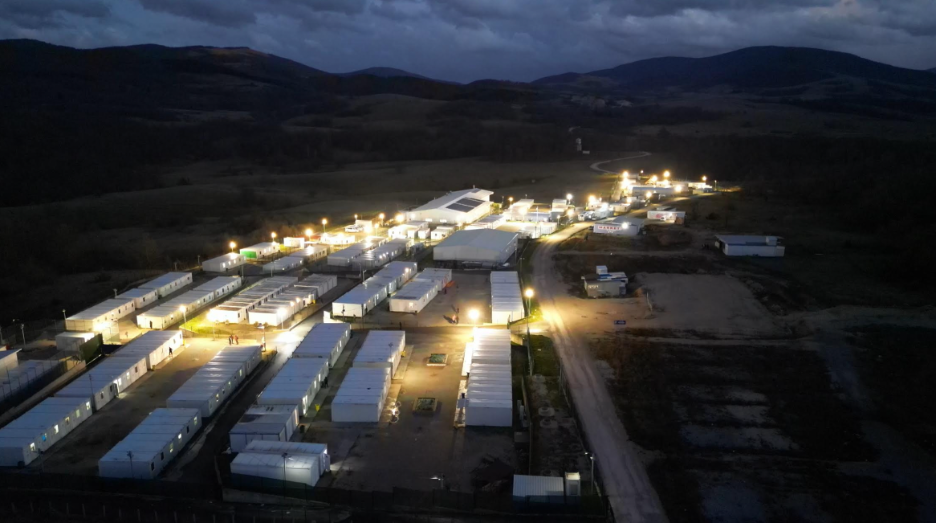
What America could learn from the E.U.’s migrant crisis.
Among the Syrians, Moroccans, and Algerians thronging the United Nations’ Camp Lipa in northwestern Bosnia, I met a young Afghan man on his way to England who typified one potential problem Europe is facing amid powerfully resurgent mass illegal immigration.
The young man said in broken English that he’d not fled the Taliban, identified by the U.S. Treasury Department as a Specially Designated Global Terrorist Group. As a matter of fact, he carried his admiration for the Islamic militants on his quest for good-paying work in England.
“Taliban good! They are good Muslim people, and I am Muslim,” the immigrant said with a thumbs up gesture, when asked what he thinks of Afghan’s rulers. “Very good.”
Enthusiasm for the Taliban is but one troubling indicator of what’s on the way to Europe these days amid expanding crowds of young male Afghans, Algerians, Tunisians, Moroccans, Syrians, Turks, and Pakistanis. They have put Europe on trajectory to match the 2014-2016 mass migration cataclysm of nearly three million, among them many dozens of violent terrorists. Huge numbers came over the so-called “Western Balkans Route” from Turkey, through Croatia and Serbia, into Hungary—until Hungary shut it down with a long fence in 2015.
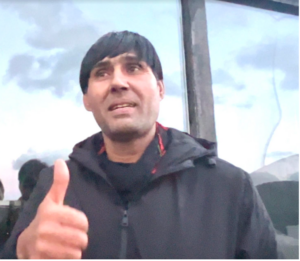
But big traffic on the Balkan Route is swelling again for new reasons, and so too is an epic political battle among the Union’s 27 members about how to address it this time.
Oddly, these developments have not triggered much interest in the United States, where a mass migration crisis at the Mexican border is now completing its third year, with nearly five million people in the country. But they very much should.
Europe’s approach to its mass migration crisis warrants American attention and close study, if for no other reason than that ideas for addressing common problems really matter right now. Candidates running for high office in the 2024 elections both in Europe and in the United States, including for president, may adopt, reject, or at least consider a raft of interesting policy ideas the E.U. member states are batting around. This is also an opportunity for American campaigners to take cues from how European electorates are falling on such a similar issue. (Hint: they’re all moving to the restrictionist Right.)
Here’s a primer.
Europe’s New Glowstick
Even the most liberal progressives of the E.U. states recoiled—hard—at what they had wrought by triggering the 2014-2016 mass migration crisis, which began when Germany’s Angela Merkel and other leaders agreed, on moral principal, to take in several million mostly Muslim Syrian war refugees (along with hundreds of thousands of economic immigrants who tagged along with them). Hundreds of thousands came up the Balkans Route.
As in the United States, those immigrants were (and still are) irresistibly attracted to lengthy asylum-claim processes that let them live in rich countries for years on generous welfare benefits with no real threat of deportation.
In 2015, the right-leaning Hungarian government of Viktor Orbán almost single-handedly shut down the route after 400,000 had gushed through in just a few months, by building a tightly patrolled 150-mile electric fence on its borders with Serbia and Croatia.
When the migrant flow diverted west to avoid the Hungarian structure, Slovenia, Austria and Slovakia built their own border fences, forcing Croatia and Serbia—stuck with the hot potato—to send those trapped behind them back south into Bosnia and Macedonia, which soon built its own border fence on the Greek border. All that pretty much put the Balkans Route out of commission.
As for the other sea routes: terror attacks, unfamiliar crime waves, riots, and assimilation resistance prompted more liberal governments to shut them down. The E.U., for instance, paid Turkey and some proxy North African nations (and violent militias) billions of Euros to stop and block immigrants.
All of it brought the numbers back to pre-crisis norms. Frontex reports show that the 1.8 million “detections” at E.U. external borders recorded during the height of 2015’s crisis fell to 204,000 for 2017, to 123,000 in 2019, and 124,000 after Covid in 2021.
But 2022 and 2023 brought two big developments that changed everything.
On January 1, Croatia joined the E.U.’s borderless “Schengen Zone,” which eliminated Croatia’s border controls with Serbia (already in the zone) and Slovenia. Secondly, Serbia ended visa requirements on countries that refused to recognize Kosovo.
Suddenly, illegal immigrants from places like Cuba, Ecuador, and India flooded into Serbia while others came in from Turkey and Greece. All knew they could take highways straight into Croatia and then on through Croatia’s newly abandoned land ports with Slovenia, finding no uniformed guards there to check papers. The way was suddenly clear for them to continue on without checks into more prosperous western European countries and file for asylum and public welfare, then live indefinitely with minimal threat of deportation.
“This route became like a glow stick, the message that this is the most viable route and that this is what you should try,” said Arpad Parducz, a Balkans specialist and researcher for the Budapest-based Mathias Corvinus Collegium educational institute. “They are moving toward it because once they’re in Schengen they are really hard to remove because the EU’s deportation schemes are very lacking.”
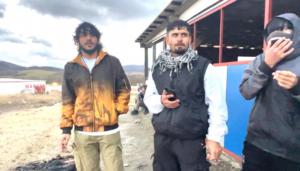
“Irregular” crossings over the E.U.’s external borders hit 330,000 with more than 962,000 asylum claims lodged in 2022—the highest since the 2016 crisis, Frontex reported. The Balkans Route accounted for more than half of these numbers, with the rest crossing the Mediterranean to Italy or Spain. Another 331,000 crossed in the first ten months of 2023, the highest total for that period since the 2015 crisis.
These developments have set off an E.U.-wide fight over what to do about it this time. Fractious E.U. members are in the throes of hammering out a union-wide strategy dubbed the “New Pact on Migration and Asylum.”
Europe’s ideas aren’t fully baked yet. But this presents a natural moment for American candidates and policymakers to wake up and consider if European ideas might work with voters and eventually to close down the U.S.-Mexico border.
What America Should Watch
The new crisis has scared liberal European governments into taking what Foreign Policy Magazine called “increasingly radical positions” to stave off a loss of power in next year’s elections to right-wing parties that advocate migration-deterring policies. Voter support for many of those parties is soaring and leading to uncharacteristically tough border policies, The Washington Post reported.
For starters, E.U. leaders successfully pressured Serbia (on threat of withdrawing some of its E.U. candidate privileges) to reinstitute visa restrictions. It did. They also pressured for a Croatian police surge along their border with Bosnia to catch immigrants and push them back. But inconsistent enforcement and unilateralism among the members has always worked to the benefit of migrants in Europe.
Croatia’s closest E.U. neighbor, Slovenia, just got a new liberal government, which started sending the message that it welcomes all comers and would even dismantle its border fence. The Slovenia lure has thwarted the crackdowns and pushbacks. It drove the immigrants to human smugglers working to move them across a narrow stretch of wooded, tough Croatian territory that separates Bosnia from the undefended Slovenian border.
Croatian police driving paddy wagons have saturated the narrow territory, hunting smugglers and immigrants with paddy wagons to be driven, as one cop reluctantly admitted, to a holding center in a tiny out-of-sight village called Dugi Dol for return to Bosnia.
None of the officers would talk on the record about these operations, smarting from intense media fire for their alleged brutality. But in Sarajevo, I ran across large groups of young Syrian men whose smugglers were transitioning them from one set of cars to taxis at a highway gas station. The smugglers then demanded my phone to delete the photos, but I refused and drove away.


It’s unclear how well the operation is working to bring down the politically troublesome numbers. In one visible testament, a hard-used van with windows painted black stood abandoned where it came to rest after a police chase opposite the Bosnian border town of Velika Kladusa, a smuggling hotspot. The windows had been painted black on the inside, and the seatless interior was strewn with packaged food and bottled soda, much of it not consumed. A police officer said everyone inside bailed out and ran but were all caught.
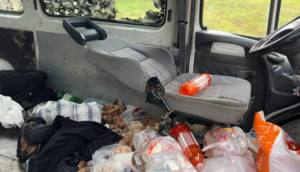
Additionally, Slovenia, Austria, and ten other E.U. countries supposedly instituted random border checkpoints in their Schengen Zone areas to intercept smuggler trucks and cars. But none of these countries have ever let on whether they were deporting anyone they caught.
If Slovenia were serious about standing up checkpoints, its 2015 fence would come in handy right now. But a tour of the structure showed it to be full of unpatrolled breaches and gaps. Anyone can drive through gates left open and unattended.
Back in Bosnia’s Camp Lipa one recent night, the young men all knew Slovenia was the place to reach. They formed groups outside the camp and prepared to head out on foot toward the Croatia border, having restocked on supplies and money at camp stores.
When asked about the Croatian police, almost everyone in one group of nine young backpackers chuckled as they gesticulated with hands how they would go over, under, and around Croatian interceptors.

“No problem!!” almost everyone in the group shouted, as they all turned and disappeared into the dark forest chanting, “Inshallah! Inshallah!”
This gap in coordinated, consistent enforcement or leniency from one E.U. country to the next reflects the very same American-style, Left-Right partisan approaches that always benefit immigrants who understand how to move across such checkerboards.
Right now, key policy features of the developing Pact on Migration and Asylum, which drafters hope will be approved by E.U. legislative bodies and then the member states before elections next year, is at risk of becoming just such a patchwork of inconsistent enforcement. But some of what’s there might deter immigration if choice were removed from the calculus and all the countries had to detain and deport.
For example, most unaccompanied minors and family units entering with children under 12 would not be detained or deported under the pact. Instead, all would be quickly welcomed and provided with accommodations. This is an American policy that’s already proven an irresistible invitation to which millions who fit those profiles have responded.
But in one nod to actual deterrence, immigrants from countries with a “low recognition rate,” meaning that asylum claims from the country are typically declined, “could” be detained at border camps for up to 12 weeks to pre-screen an international protection claim. Authorities would have 12 more weeks to return rejected applicants to home countries.
Of course, the Achilles heel is that, as the document is written, the decision whether to detain or deport is left up to individual countries rather than universally required, which would make it truly deterring.
There are other weak links at the moment. When immigrants overwhelm one of the external countries, the other members would have to accept a quota share of up to a total of 120,000 for the bloc, eventually. Any country that refuses its quota share would pay $20,000 Euros per rejected person, an expensive penalty for not taking them in.
As for deporting those rejected for asylum, there’s no language about timelines, mandates, or who pays for those. From an immigrant’s standpoint, the high degree of optionality poses no serious deterring risk, only a high probability of finding incentivizing accommodations somewhere in the Union.
But this is far from over. As European populations move rightward politically, the negotiations bear watching. The pressure on Croatia and Serbia to crack down provides good reason to suspect tougher innovative ideas are coming that might interest American candidates.
One example would be the intriguing new third-country arrangements the E.U. began pursuing in the new crisis. Facing massive new surges in mid-2023, the E.U. cut a preliminary billion-Euro deal with Tunisia to intercept and detain Europe-bound immigrants before they can board boats. The E.U. has lately reached out to Morocco, Egypt, Libya, Tunisia, and Serbia with similar interception and detention deals. Can anyone imagine paying Panama and Costa Rica to hold back migrants moving through the Darien Gap and maybe even have those nations deport them?
Italy seemed so desperate for these to succeed that it just proposed transporting asylum claimants to wait out their adjudications in Albania, a non-E.U. country, rather than leave them free to disappear inside the E.U. This idea is most similar to the American “Remain in Mexico” policy under Donald Trump, which proved that immigrants won’t bother coming if they know they can’t reach their destination and will instead get stuck for years in a lesser country.
While much remains to be forged in Europe’s final pact, whatever happens in Europe need not stay there.
The American Mind presents a range of perspectives. Views are writers’ own and do not necessarily represent those of The Claremont Institute.
The American Mind is a publication of the Claremont Institute, a non-profit 501(c)(3) organization, dedicated to restoring the principles of the American Founding to their rightful, preeminent authority in our national life. Interested in supporting our work? Gifts to the Claremont Institute are tax-deductible.
Biden’s border crisis will have long-lasting effects on American society.
Without major policy changes that secure our border, America will be overrun.
Europe can’t look the other way forever.

